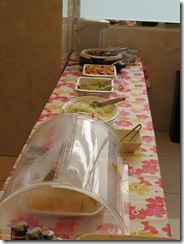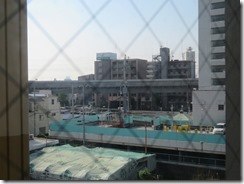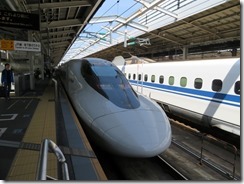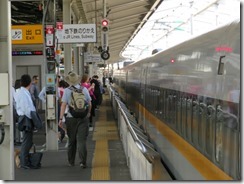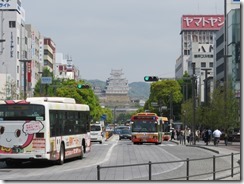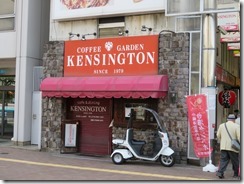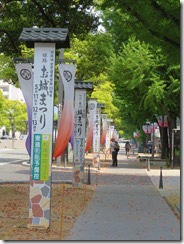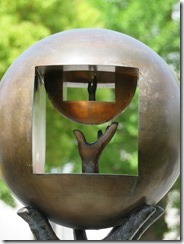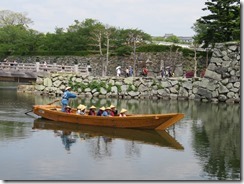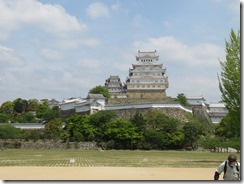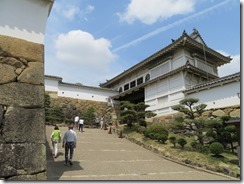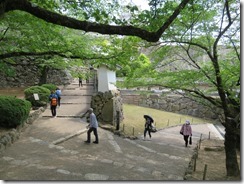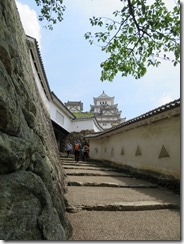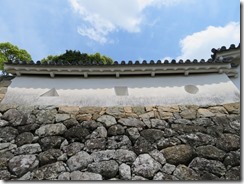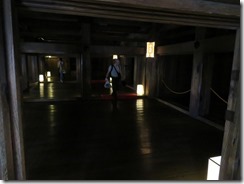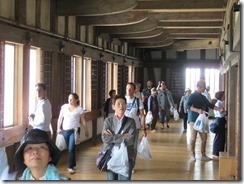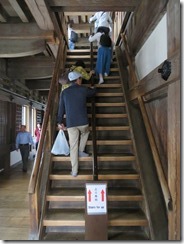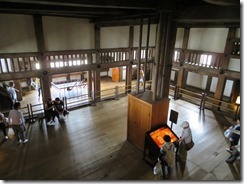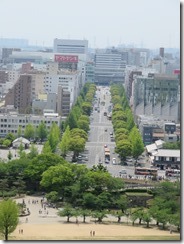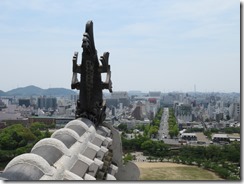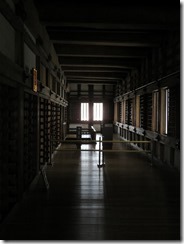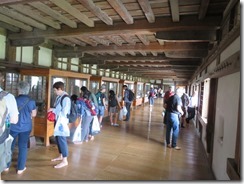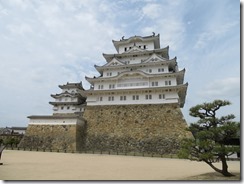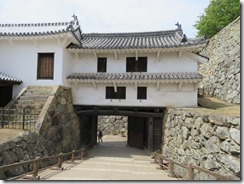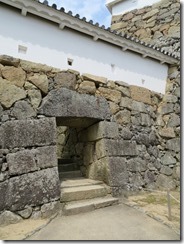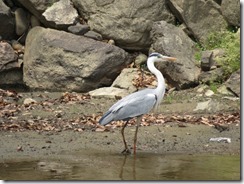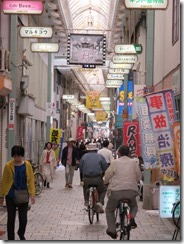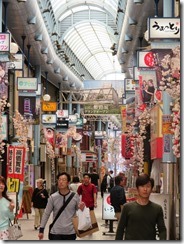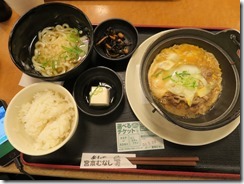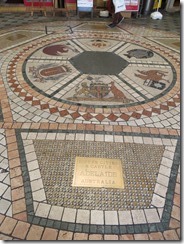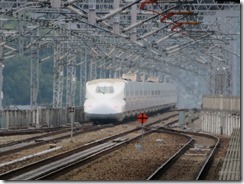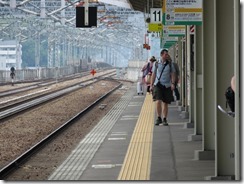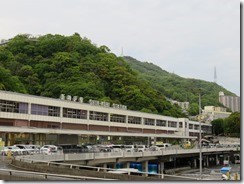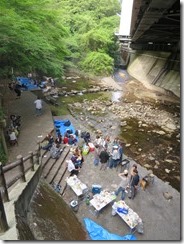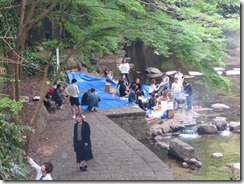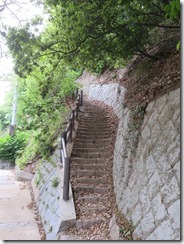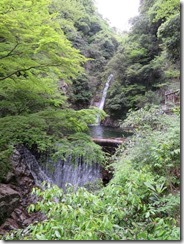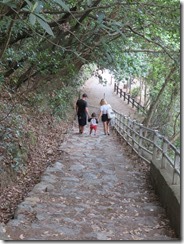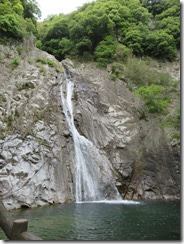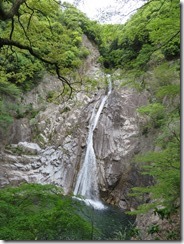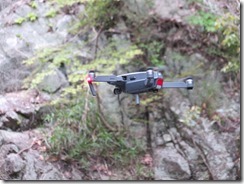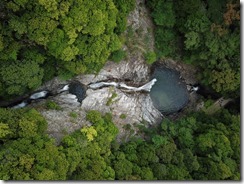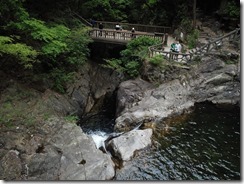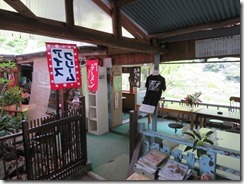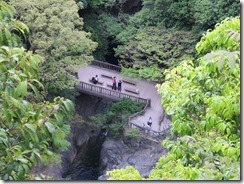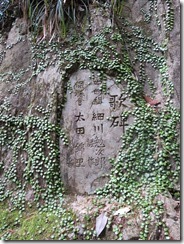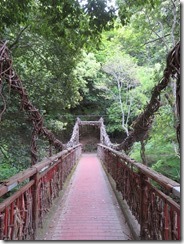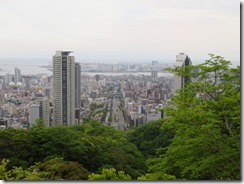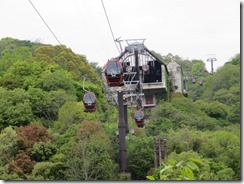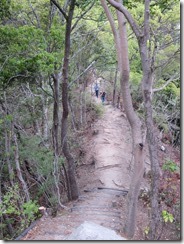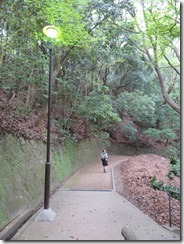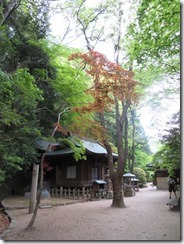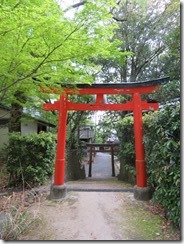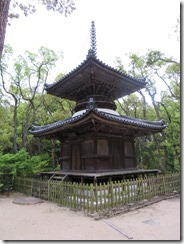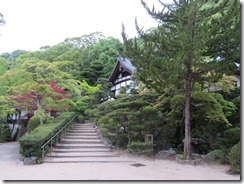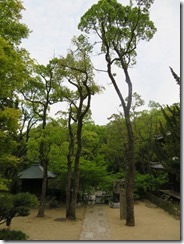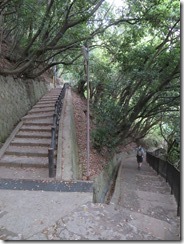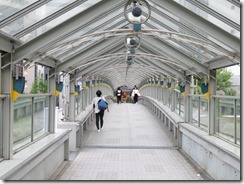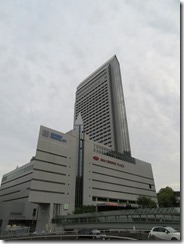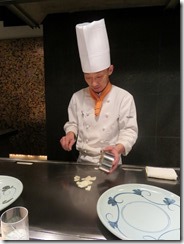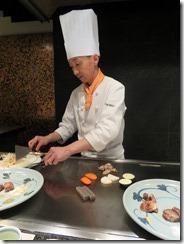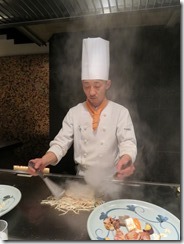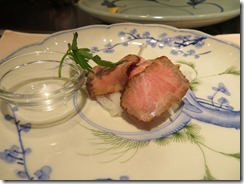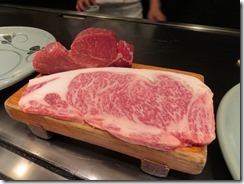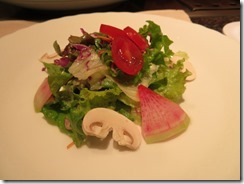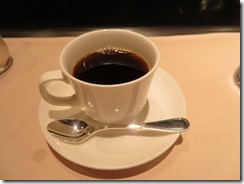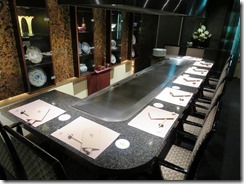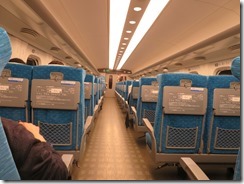After my last two trips to Japan, I constantly found myself discovering I’d passed within a block of – or sometimes even right out side – some place that’s a famous attraction, or looks really nice to try. Shortly after my last trip in December, I discovered I’d managed to do the exact reverse – specifically, the melon bread shop I randomly came across in Asakusa by pure chance and street-wandering is actually massively famous in Japan, and people come from far and wide to buy their melon bread. Go figure.
Today we returned to our old Toyoko Inn style breakfasts. One side note, our last Toyoko Inn in Osaka back in 2010 had the Tokaido Main Line passing right behind it. In this hotel, the shinkansen line is quite visible outside the window (and for James, quite audible too). Fortunately, since all shinkansen passing through stop at Shin-Osaka, nothing’s going at full speed.
Then we headed out in order to do something we weren’t able to do on our first trip back in 2010: actually climb the main keep of Himeji Castle. We booked a shinkansen from Shin-Osaka without a hitch (the slowest, all-stops Kodama, though) and arrived at Himeji in almost a blink of an eye.
We exited the station, and there was the castle, visible at the end of the main road. I don’t seem to have mentioned it in my blog from back then, but I’m pretty sure the station was being refurbished as well on our last visit, because for some reason we walked along the underground shopping mall most of the way to the castle, and our first glimpse of the building wasn’t until we were pretty much standing outside the front gate. This time we could see it all the way along the main street, in all its shining white glory.
So we reached the castle and headed inside. To recap, last time they’d just started a massive restoration of the main keep, so we arrived just after they’d closed the building to visitors, but before they’d opened up the observation platform in the scaffolding they’d erected. This time, we decided to focus our efforts on the main keep only, having seen all the peripheral structures on our last visit, and it was certainly an impressive keep.
Six storeys tall and filled with all manner of defences, the keep was built in 1609, and even though it’s needed a couple of face-lifts over the years, it really is quite a nice building. Had to carry our shoes throughout in a plastic bag, though, which was a little bit annoying. Tried to take a panoramic photo of the view, but there was mesh over the windows preventing me from photographing anything that wasn’t directly in front of me.
Once we’d finished admiring the main keep, we wandered back towards the train station along a shopping street parallel to the main street looking for somewhere for lunch.
Most places seemed to be not-food shops, though, but we turned left onto another shopping street, and right onto yet another, before finding a teishoku restaurant on a main road – one of a chain named Munashi. I had a beef-and-egg set with udon soup (kinda like oyako don, only with beef instead of chicken… and with the rice in a separate bowl), while James had “stamina” chicken (Japanese has “stamina” cuisine, which is a dish that helps you to get enough energy to get you through the day – I think exactly what that means depends on the dish, but in James’ case, it had lots of garlic).
After lunch, we headed back to the station, and entered the ticket office. Once again, we found a huge queue, and having learnt our lesson from yesterday, this time we decided to head straight for the shinkansen platform and try for the non-reserved seats. When the shinkansen I expected to show didn’t (possibly because I was misreading the timetable), we went to the ticket office inside the station and booked the next shinkansen without issue. Lesson to be learnt: try the inside ticket office if the outside one is crowded.
On our last trip to Himeji, we were travelling between hotels, so Himeji was our sole activity that day. On this trip, we did it as a day-trip from Osaka, so we still had a half-day. So we went to Shin-Kobe, the shinkansen station serving the city of Kobe (the capital and largest city of Hyogo Prefecture, and sixth-largest city in Japan).
For almost literally right on the back doorstep of Shin-Kobe Station is Nunobiki Falls, regarded as one of the three greatest falls in Japan, along with Nachi Falls (which I visited last trip) and Kegon Falls in Tochigi Prefecture (though signage near the waterfall was much more humble, only referring to the falls as one of the best hundred waterfalls). By “almost literally”, what I mean is you walk out the front door of the station, down a passage which passes underneath, and suddenly you’re already in a tree-covered mountain path. The waterfall is just five hundred metres away.
(An alternate option I’d hoped to visit here was the Nunobiki Herb Garden, a kind of botanic garden focusing on flowers and edible herbs at the top of a mountain – it’s accessed by the Shin-Kobe Ropeway, which travels for one and a half kilometres. Trouble is, by the time we reached Shin-Kobe, the garden would be closing in only a bit over an hour, so maybe it’s something I’ll have to leave for next time.)
It was an extremely nice stroll up the mountain, though – albeit uphill all the way. First, after emerging from the back of Shin-Kobe Station, we found a whole group of people picnicking along the river underneath – some of them even set up literally beneath the station. I was quite surprised by how many people there were – I thought it was a fairly typical summertime activity, but uncommon otherwise, though to be fair I couldn’t really say for sure.
In any case, we headed up the mountain (first passing just a handful of houses) and went to see the falls. They were certainly quite impressive, though a little tricky to photograph through the greenery. A couple of the falls had viewing platforms installed over the river, like bridges that didn’t lead anywhere. Quite a peaceful area, though. And for some reason, large numbers of westerners passing through as well – I wouldn’t have really thought of this as a major tourist attraction. James launched his drone to take some photos of the main falls from the air as well.
We decided to head uphill to see what else we could see, coming across a small tea house above the main falls, then a small shrine, then a lookout area with views over Kobe.
The area maps on the walk also had hand-written maps taped to them with suggested walking times between sights on the walk, and it had another location only a little further up the walk labeled “Ivy Bridge”, so we decided to head there and have a look. It was a suspension bridge with vines wrapped around the cables – clearly added manually after the fact, but still an impressive look nonetheless.
A side path continued on the other side of the bridge, so we decided to follow it up, soon finding ourselves walking along a ridgeline with the ground dropping off sharply on both sides – and an even more impressive view over Kobe. We kept climbing until we were right underneath the ropeway gondolas, but decided it was probably time to turn back. As we did so, we passed several groups of westerners on their way up as well, who (just like us) were following the path because it looked interesting, rather than because we knew where it lead.
We headed back downhill by a slightly different route, finding a small valley which contained Kaiun Fukutoku Benzaiten Shrine and Tokko-in Temple. Both quite closed by this point in the day, but both quite pretty nonetheless.
Continuing down hill, we eventually arrived back at the station. Since we were in Kobe, there was something I’d been wanting to try for dinner: authentic Kobe beef. I asked at the station information counter if there was any restaurant offering it nearby, and there was – at the ANA Crowne Plaza Hotel, which we could reach from the station without even going back down to street level.
Trouble is, as a restaurant in a hotel named “Crowne Plaza”, we knew it was going to be obscenely expensive, but hey – how often do you get to eat Kobe beef? And I’m not talking about the stuff they sell in Australia called “wagyuu” – there’s no official certification of that anyway. But this restaurant… let’s just say the cheapest item on the menu (which was just regular beef too, not Kobe beef) cost about as much as a night at Toyoko Inn in a twin room for the two of us, and leave it at that.
The restaurant contained just us two and a couple, so not exactly packed. As a hotel restaurant, the staff could also speak pretty good English – for some reason, I asked for a Japanese menu anyway, though it still had English included all the same. Basically at this place, the chef stands and cooks on a hotplate in front of you. The Kobe beef sets we ordered included more than just the beef, there were also entrees (a choice between smoked salmon and regular roast beef – I decided to have the beef, so I could compare the two, but James had the salmon), a salad, a small plate of pickles, a side of bread or rice (we had rice), and the chef also cooks a succession of vegetables as well.
Let me say this, though: the meat was absolutely scrumptious. So tender, so juicy.
James ordered the tenderloin cut, while I got the sirloin, but when they arrived we decided to just share both. The meal finished with coffees, to which James and I added cream and sugar and slugged down so that we’d look at least slightly refined and full of culture, but we both would have preferred to have the taste of the meat lingering in our mouths rather than coffee. We were, however, both pleasantly surprised to feel quite sated after our meal – we were kind of expecting the usual fancy restaurant offerings of dainty piles of things with jus drizzled everywhere and whatnot, but it was actually big slabs of meat, big chunks of vegetables, several side dishes, and so forth.
Back at the station, we checked in for our ride back to Shin-Osaka, and returned to our hotel. Let’s see if we can manage to not stay up too late this time (but as James is having to tech support things back home over the internet, that may be wishful thinking).
Tomorrow’s weather is forecast to rain. Nooooo.
Today’s photo count: Seven hundred and sixty-nine
Today’s pedometer count: 14,941 steps, for 10.7km
Today’s goshuin count: None, but I wasn’t really expecting any
Today’s stamp count: Three – Himeji Station, Shin-Kobe Station and Nunobiki Falls. I’ve actually been quite impressed with the last bunch of station stamps – Shin-Osaka, Himeji and Shin-Kobe all have those big stamping machines with a lever, which I’ve had trouble getting a good impression with in the past, but these have all come out quite cleanly, and the stamps are very bright and quite detailed.


